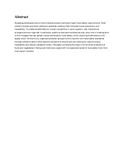| dc.contributor.author | Narrod, Clare | |
| dc.contributor.author | Roy, Devesh | |
| dc.contributor.author | Okello, Julius | |
| dc.contributor.author | Avendaño, Belem | |
| dc.contributor.author | Rich, Karl | |
| dc.contributor.author | Thorat, Amit | |
| dc.date.accessioned | 2013-12-02T11:35:19Z | |
| dc.date.available | 2013-12-02T11:35:19Z | |
| dc.date.issued | 2009-02 | |
| dc.identifier.citation | Food Policy Volume 34, Issue 1, February 2009, Pages 8–15 | en |
| dc.identifier.uri | http://www.sciencedirect.com/science/article/pii/S0306919208000778 | |
| dc.identifier.uri | http://erepository.uonbi.ac.ke:8080/xmlui/handle/123456789/61419 | |
| dc.description.abstract | Accessing developed country food markets entails meeting stringent food safety requirements. Food retailers impose protocols relating to pesticide residues, field and pack house operations, and traceability. To enable smallholders to remain competitive in such a system, new institutional arrangements are required. In particular, public–private partnerships can play a key role in creating farm to fork linkages that can satisfy market demands for food safety, while retaining smallholders in the supply chain. Furthermore, organized producer groups monitoring their own food safety standards through collective action often become attractive to buyers who are looking for ways to ensure traceability and reduce transaction costs. This paper compares the ways in which small producers of fruits and vegetables in Kenya and India have coped with increased demands for food safety from their main export markets. | en |
| dc.language.iso | en | en |
| dc.publisher | University of Nairobi | en |
| dc.title | Public–private partnerships and collective action in high value fruit and vegetable supply chains | en |
| dc.type | Article | en |
| local.publisher | Agricultural Economics | en |

